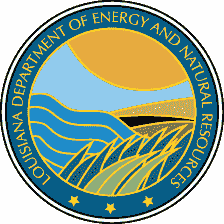Technology Assessment Division
Kids' Energy Quiz
Answers at bottom
1. What chemical element gives coal its energy?
A. Oxygen
B. Carbon
C. Zinc
2. Parabolic (or curved) mirrors are used in the production of which type of energy?
A. Solar Energy
B. Tidal Energy
C. Nuclear Energy
3. When liquid petroleum comes out of the ground, it is called:
A. Crude Oil
B. Gas
C. Diesel
4. Which fuel is used most for generating electricity?
A. Coal
B. Natural Gas
C. Uranium
5. There are two types of energy; energy that is stored and energy of motion. Energy that is stored is called:
A. Kinetic Energy
B. Potential Energy
C. Nuclear Energy
6. Energy produced by electrons pushing through wires is called:
A. Solar Energy
B. Muscle Energy
C. Electrical Energy
7. A factory that takes crude oil and turns it into gasoline and other useful products is called:
A. Refinery
B. Distillery
C. Paper Mill
8. Clue: I'm saving energy when I'm properly set.
A. The table
B. Thermostat
C. Offensive Line
9. There are two types of energy. Energy that is stored up and energy of motion. Energy of motion is called:
A. Kinetic Energy
B. Potential Energy
C. Radiant Energy
10. What were the most important energy sources during pioneer days?
A. Solar and Wind
B. Nuclear and Hydrogen
C. Wood and Muscle
11. Which of these practices are good energy conservation practices?
A. Recycling
B. Carpooling
C. Walking or riding your bicycle whenever possible
D. All of the above
12. Lighting in the home uses more energy than heating water?
A. True
B. False
13. Transportation is the largest use of petroleum in the United States.
A. True
B. False
14. Who invented the light bulb?
A. Steve Jobs
B. John Watt
C. Thomas Edison
15. What is a form of recycling that helps save landfill space by reusing yard wastes?
A. Composting
B. Gardening
C. Rainwater capture
16. The basic unit for measuring oil is a barrel. How many gallons are in a barrel of oil?
A. 25
B. 42
C. 100
17. Energy that comes from the sun is called:
A. Kinetic Energy
B. Solar Energy
C. Anxious Energy
18. What kind of energy is produced from the water flowing in rivers?
A. Geothermal Energy
B. Hydroelectric Energy
C. Radiant Energy
D. None of the above
19. Keeping pots covered while cooking helps keep the heat in and makes food cook quicker.
A. True
B. False
20. One fourth of all energy in the U.S. is used for:
A. Lighting
B. Transportation
C. Cooking
21. Which of the following is NOT a renewable source of energy?
A. Solar
B. Petroleum
C. Hydroelectric
22. Non-renewable resources are energy sources that we will run out of if we don't start conserving energy.
A. True
B. False
23. Which nonrenewable resource do we have the largest supply of in the U.S.?
A. Coal
B. Petroleum
C. Natural Gas
24. What Department of the U.S. Government oversees energy problems and research?
A. Department of the Interior
B. Department of Energy
C. Department of Education
25. Where do our bodies get energy?
A. From small nuclear generators
B. From the sun
C. From the food and drink we consume
26. Which nonrenewable resource do we have the smallest supply of in the U.S.?
A. Petroleum
B. Natural Gas
C. Coal
27. Fuels that were formed millions of years afo from dinosaurs and plants that died and decayed in the soil are called:
A. Dino Fuels
B. Fossil Fuels
C. Renewable Fuels
28. Every time you open the oven door during cooking you lose 25-50 degrees of heat.
A. True
B. False
29. A way to stop air leakage around windows is to use a putty-like material called:
A. Bubblegum
B. Caulking
C. Playdough
30. The average shower uses ____gallons of water every minute.
A. 5
B. 10
C. 20
31. Louisiana is one of the top petroleum producing states
A. True
B. False
32. Louisiana is one of the top natural gas producing states
A. True
B. False
33. How can you conserve energy in a car or truck?
A. Ensure proper tire pressure
B. Clean and change air filter
C. Change oil and oil filter
D. Reduce speed
E. All of the above
34. What do families use the most natural gas for?
A. Transportation
B. Home heating
C. Lighting
35. Which energy task accounts for the second-largest energy usage?
A. Lighting
B. Hot Water
C. Air conditioning
36. How can you conserve energy in your home?
A. Add insulation
B. Turn off lights
C. Adjust thermostats
D. Weatherstrip and/or caulk windows and doors
E. All of the above
Answers:
1-B, 2-A, 3-A, 4-A, 5-B, 6-C, 7-A, 8-B, 9-A, 10-C, 11-D, 12-B, 13-A, 14-C, 15-A, 16-B, 17-B, 18-B, 19-A, 20-B, 21-B, 22-A, 23-A, 24-B, 25-C, 26-B, 27-B, 28-A, 29-B, 30-A, 31-A, 32-A, 33-E, 34-B, 35-B, 36-E
